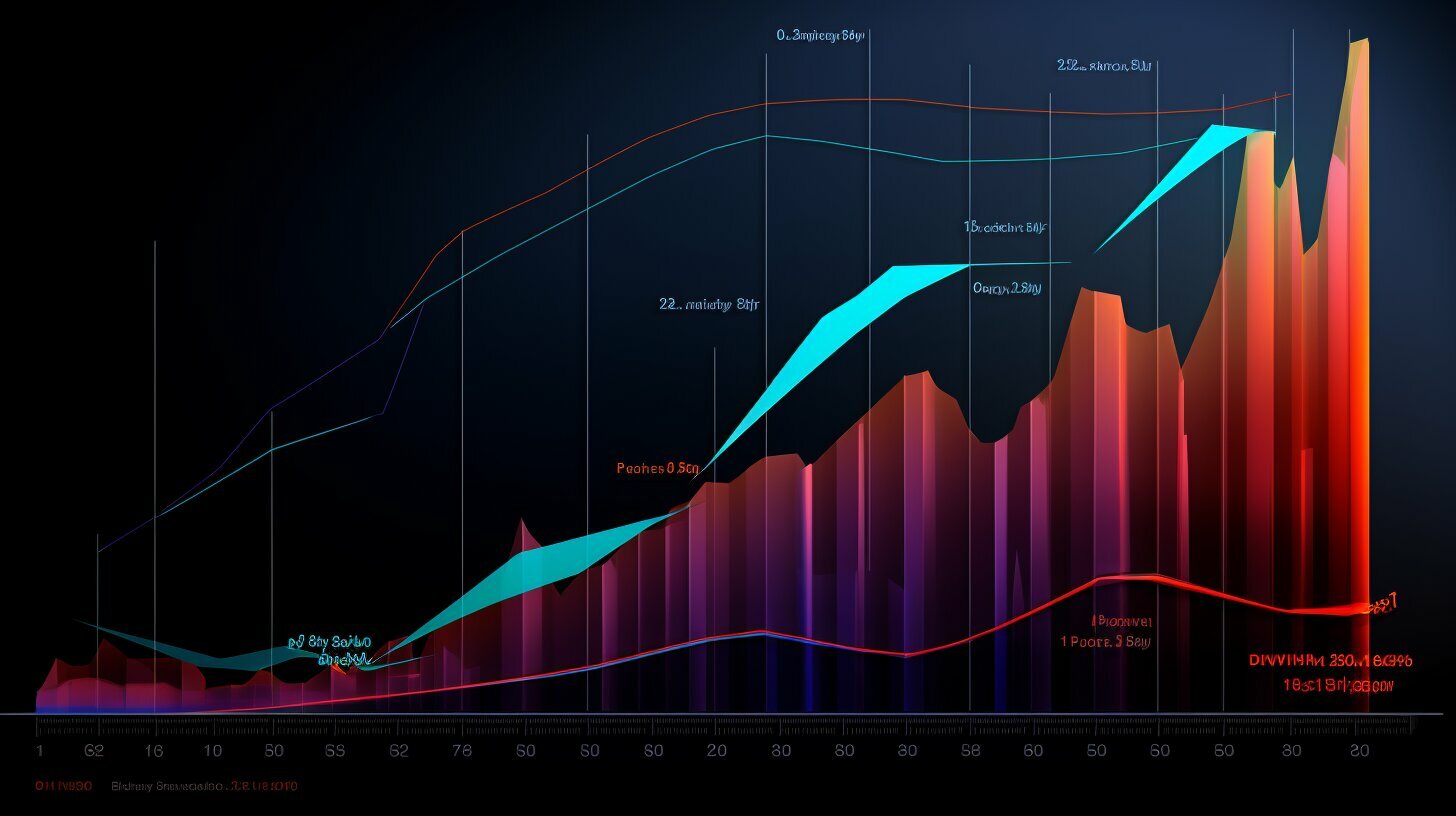Measuring the return on investment (ROI) of your social media campaigns is crucial to understanding the effectiveness and value of your social media marketing efforts. It provides insights into the profitability and success of your strategies, allowing you to make data-driven decisions and optimize your campaigns for better results.
ROI can be calculated by comparing the profit earned from social media marketing to the total cost of investment. For paid social media campaigns, it is relatively easier to calculate ROI based on monetary metrics such as revenue generated. However, for organic social media, ROI can be quantified by non-monetary metrics such as follower count or post impressions. This comprehensive measurement approach ensures that you have a holistic understanding of the impact of your social media campaigns.
Choosing the right tools for calculating social media ROI is essential. Platforms like Facebook Ads with Facebook Pixel and Google Analytics with UTM parameters can provide accurate and detailed data for analysis. These tools enable you to track and measure various metrics, including conversions, click-through rates, and engagement levels, allowing you to evaluate the success of your campaigns and make informed decisions for future strategies.
Monitoring ROI in relation to market fluctuations is crucial for maintaining a strong social media marketing strategy. By staying updated on market trends and consumer behaviors, you can adjust your social media campaigns accordingly, ensuring that you are targeting the right audience at the right time with the right message.
Reporting on social media performance and ROI is vital for assessing the effectiveness of your campaigns. It is recommended to analyze each social media platform, ad format, and ad placement separately, as this provides a comprehensive view of your marketing efforts. By aligning the metrics with your marketing objectives, you can identify the strengths and weaknesses of your campaigns, allowing you to make data-driven decisions for future strategies.
Key Insights:
- Measuring social media ROI is crucial for understanding the effectiveness of your marketing efforts.
- ROI can be calculated using monetary and non-monetary metrics, depending on the nature of your campaigns.
- Choosing the right tools, such as Facebook Ads with Facebook Pixel and Google Analytics, is essential for accurate ROI measurement.
- Monitoring ROI in relation to market fluctuations helps in adapting your strategies to changing consumer behaviors.
- Reporting on social media performance and ROI allows you to assess the success and areas for improvement in your campaigns.
Why Measuring Social Media ROI is Important
Measuring the ROI of your social media campaigns is essential for gaining insights into their performance and determining their impact on your overall marketing efforts. ROI, or return on investment, is a key metric that shows the profitability and effectiveness of your social media marketing strategy. By measuring ROI, you can evaluate the success of your campaigns, make data-driven decisions, and optimize your marketing efforts for better results.
One of the reasons why measuring social media ROI is important is because it provides valuable insights into the effectiveness of your marketing campaigns. By tracking the return on investment, you can determine which campaigns are generating the most revenue or engagement and which ones are falling short. This information allows you to allocate your resources more effectively, focusing on the strategies that deliver the best results.
Another benefit of measuring social media ROI is the ability to justify your marketing budget and demonstrate the value of your social media efforts. By quantifying the return on investment, you can show the impact of your campaigns on the company’s bottom line, which is crucial for securing future budget allocations and resources.
To accurately measure social media ROI, it is important to choose the right tools and platforms. Facebook Ads with Facebook Pixel and Google Analytics with UTM parameters are popular options that offer robust tracking and reporting capabilities. These tools allow you to track conversions, revenue, and other key metrics, providing you with the necessary data to calculate ROI accurately.
In conclusion, measuring social media ROI is important for evaluating the performance of your campaigns, justifying your marketing budget, and optimizing your strategies. By tracking ROI and utilizing the right tools, you can gain valuable insights, make data-driven decisions, and improve the effectiveness of your social media marketing efforts.
Calculating Social Media ROI for Paid Campaigns
Calculating the ROI of paid social media campaigns involves analyzing monetary metrics, such as revenue generated, to determine the effectiveness of your advertising spend. By tracking the revenue generated from your paid social media campaigns and comparing it to the total cost of investment, you can gain valuable insights into the return on your advertising investment.
One approach to calculating social media ROI for paid campaigns is to use the formula: ROI = (Revenue – Cost) / Cost * 100. This formula allows you to determine the percentage return on your advertising investment and assess the profitability of your campaigns.
It’s important to track and measure various metrics to accurately calculate ROI for your paid social media campaigns. These metrics can include the number of conversions, click-through rates, and cost per click. By analyzing these metrics, you can identify which campaigns are driving the most revenue and make data-driven decisions to optimize your advertising strategy.
Additionally, utilizing tools such as Facebook Ads with Facebook Pixel or Google Analytics with UTM parameters can provide more detailed insights into the performance of your paid social media campaigns. These tools allow you to track conversions, measure the effectiveness of different ad formats and placements, and gain a deeper understanding of your audience’s behavior. The data collected can help you fine-tune your targeting efforts and allocate your advertising budget more effectively, ultimately maximizing your social media ROI.
| Metrics | Definition |
|---|---|
| Conversions | The number of desired actions taken by users, such as purchases or sign-ups, as a result of seeing and interacting with your paid social media ads. |
| Click-through Rates | The percentage of users who click on your paid social media ad after viewing it. |
| Cost per Click | The average amount you spend on each click generated by your paid social media ads. |
Conclusion:
Calculating the ROI of your paid social media campaigns is a vital step in determining the effectiveness and profitability of your advertising efforts. By analyzing monetary metrics such as revenue generated, conversions, click-through rates, and cost per click, you can gain valuable insights into the performance of your campaigns. Utilizing tools like Facebook Ads with Facebook Pixel and Google Analytics with UTM parameters can provide more in-depth data to optimize your targeting and improve your social media ROI. Remember to regularly track and monitor these metrics to make data-driven decisions and continuously refine your advertising strategy.
Quantifying Social Media ROI for Organic Campaigns
Quantifying the ROI of organic social media campaigns requires tracking non-monetary metrics, such as follower count and post impressions, to assess the success of your organic content. While monetary metrics are often used to calculate ROI for paid social media campaigns, organic campaigns rely on other indicators to measure performance and overall effectiveness.
One way to track the success of your organic campaigns is by monitoring the growth and engagement of your social media followers. A higher follower count indicates an increased reach and potential for your content to be seen by a larger audience. Additionally, tracking post impressions can help determine the visibility and impact of your organic posts on social media platforms.
| Metrics | Definition |
|---|---|
| Follower Count | The total number of followers on your social media accounts. |
| Post Impressions | The number of times your organic posts have been viewed by users. |
By analyzing these metrics, you can gain insights into the effectiveness of your organic campaigns and make data-driven decisions to optimize your social media strategy. For example, if you notice a significant increase in follower count after implementing a particular content strategy, it indicates that your content is resonating with your target audience and driving organic growth.
Key Takeaways:
- Quantifying the ROI of organic social media campaigns requires tracking non-monetary metrics such as follower count and post impressions.
- Follower count indicates the reach and potential of your content, while post impressions reflect the visibility and impact of your organic posts.
- By analyzing these metrics, you can optimize your social media strategy and make data-driven decisions to improve campaign performance.
Tracking non-monetary metrics for organic campaigns provides valuable insights into the success of your social media efforts. Utilize these metrics to understand the impact of your organic content and refine your strategy to achieve better ROI. Remember, while monetary metrics may be more straightforward to calculate for paid campaigns, non-monetary metrics play a crucial role in evaluating the effectiveness and overall value of organic social media campaigns.
Choosing the Right Tools for Calculating Social Media ROI
Selecting the right tools, such as Facebook Ads with Facebook Pixel and Google Analytics with UTM parameters, is crucial for accurately calculating and analyzing social media ROI. These tools provide valuable insights into the performance of your social media campaigns and help you understand the impact of your marketing efforts. With Facebook Ads and Facebook Pixel, you can track conversions, measure engagement, and attribute revenue to specific campaigns and ads. Google Analytics, on the other hand, allows you to track website traffic, monitor user behavior, and analyze the effectiveness of your social media marketing.
The Benefits of Facebook Ads with Facebook Pixel
Facebook Ads with Facebook Pixel offer a range of benefits for measuring social media ROI. The Facebook Pixel is a small piece of code that can be added to your website to track user activity and conversions. With this tool, you can analyze how users interact with your website after clicking on a Facebook ad, measure the effectiveness of your campaigns, and optimize your targeting and messaging based on real-time data. Facebook Ads also provide detailed metrics on ad performance, such as reach, impressions, clicks, and conversions, allowing you to accurately measure the ROI of your paid social media campaigns.
The Power of Google Analytics with UTM Parameters
Google Analytics is another powerful tool for measuring social media ROI. By using UTM parameters, you can track the performance of your social media campaigns and gain insights into user behavior on your website. UTM parameters are tags added to the URLs of your social media posts, which allow Google Analytics to track the source, medium, and campaign name associated with each click. With this information, you can analyze the effectiveness of your social media marketing, measure conversions and revenue generated, and identify the platforms and campaigns that drive the most engagement and sales. Google Analytics also provides in-depth reporting and analysis features that can help you understand audience demographics, user flow, and conversion paths, enabling you to make data-driven decisions for your social media strategy.
| Tool | Key Features |
|---|---|
| Facebook Ads with Facebook Pixel | – Track conversions and measure engagement – Attribute revenue to specific campaigns and ads – Optimize targeting and messaging based on real-time data – Detailed metrics on ad performance |
| Google Analytics with UTM Parameters | – Track performance of social media campaigns – Gain insights into user behavior on your website – Measure conversions and revenue generated – Identify platforms and campaigns driving engagement and sales – In-depth reporting and analysis features |
Monitoring ROI in Relation to Market Fluctuations
Understanding how ROI fluctuates in relation to changes in the market is vital for consistently evaluating the performance of your social media campaigns. As market conditions shift, consumer behavior and preferences can change, impacting the effectiveness of your marketing efforts. To effectively monitor ROI in relation to market fluctuations, consider the following:
- Track key market indicators: Stay informed about market trends, economic factors, and industry-specific developments that can influence consumer sentiment and purchasing decisions. Keep an eye on factors such as GDP growth, interest rates, inflation, and industry reports to gain insights into market fluctuations that may impact your social media ROI.
- Regularly analyze campaign performance: Continuously monitor the performance of your social media campaigns to identify any correlation between ROI and market fluctuations. Use social media analytics tools to track key metrics like engagement rates, click-through rates, and conversion rates. By comparing these metrics against market indicators, you can identify patterns and trends that provide valuable insights into how ROI is affected by market changes.
- Adjust your strategy accordingly: Based on the analysis of ROI in relation to market fluctuations, make data-driven decisions to optimize your social media marketing strategy. Adapt your messaging, targeting, and creative elements to align with consumer preferences and capitalize on market opportunities. By staying agile and responsive to market changes, you can maximize the effectiveness of your social media campaigns and achieve higher ROI.
By regularly monitoring and analyzing ROI in relation to market fluctuations, you can gain a deeper understanding of the dynamics between your social media campaigns and the broader market. This knowledge will empower you to make informed decisions about your marketing strategy, ultimately driving better results and maximizing the ROI of your social media efforts.
| Key Steps for Monitoring ROI in Relation to Market Fluctuations | Benefits |
|---|---|
| Track key market indicators | – Gain insights into market trends and economic factors |
| Regularly analyze campaign performance | – Identify patterns and trends in ROI |
| Adjust your strategy accordingly | – Optimize messaging and targeting based on market changes |
Reporting on Social Media Performance and ROI
When reporting on social media performance and ROI, it is essential to analyze each platform, ad format, and ad placement separately to gain insights into the effectiveness of your campaigns. By examining the performance of individual platforms, you can identify which ones are driving the most engagement and conversions for your business. This allows you to allocate your resources and budget more effectively, ensuring that you are investing in the most profitable channels.
One way to track platform-specific performance is by using analytics tools provided by social media platforms themselves. These tools provide valuable information about reach, impressions, clicks, and conversions, giving you a comprehensive view of your campaign’s performance. Additionally, you can use third-party analytics tools like Sprout Social or Hootsuite to consolidate data from different platforms into a single dashboard for easier analysis.
Furthermore, it is crucial to evaluate the performance of different ad formats and placements within each platform. For example, you may find that video ads outperform image ads in terms of engagement and conversion rates on Facebook, or that ads placed in the Instagram Stories feature generate more clicks and conversions than ads in the main feed. By understanding which ad formats and placements are delivering the best results, you can optimize your campaigns for maximum ROI.
Table: Example of Analyzing Social Media Performance on Facebook
| Metrics | Campaign A | Campaign B |
|---|---|---|
| Reach | 10,000 | 8,000 |
| Impressions | 50,000 | 40,000 |
| Clicks | 500 | 600 |
| Conversions | 20 | 30 |
In the example table above, Campaign B outperforms Campaign A in terms of reach, impressions, clicks, and conversions. This data suggests that Campaign B is more effective in driving engagement and conversions, indicating that you may want to allocate more budget towards Campaign B or replicate its successful elements in future campaigns.
In conclusion, analyzing social media performance and ROI requires a detailed examination of each platform, ad format, and ad placement. By leveraging analytics tools and conducting platform-specific analysis, you can gain valuable insights into the effectiveness of your campaigns and make data-driven decisions to optimize your social media marketing strategy.
Presenting Key Insights and Identifying Areas for Improvement
Presenting key insights and identifying areas for improvement based on your social media ROI analysis is crucial for continuously optimizing the performance of your campaigns. By analyzing the data collected from your social media campaigns, you can gain valuable insights into what is working and what needs improvement. These insights can help you make informed decisions and strategic adjustments to maximize your ROI and achieve your marketing objectives.
One effective way to present key insights is through data visualization. Creating visually appealing charts and graphs can make it easier to understand and communicate your findings. For example, you can use a table to compare the performance of different social media platforms, highlighting the ones that are driving the highest ROI. Additionally, you can use a line graph to visualize the trend of your ROI over time, identifying any fluctuations or patterns that may require attention.
Another important aspect of presenting key insights is to provide actionable recommendations for improvement. This can be done by identifying the areas where your campaigns are underperforming and suggesting specific strategies to address these shortcomings. For instance, if your organic campaign is not generating enough engagement, you can recommend increasing the frequency of posting, optimizing content for better visibility, or leveraging user-generated content to boost audience engagement.
Furthermore, it is essential to align your key insights with your overall marketing objectives. This means evaluating the performance of your social media campaigns in relation to your specific goals and targets. For example, if your objective is to increase brand awareness, you may want to focus on metrics such as reach and impressions. On the other hand, if your goal is to drive conversions, you should prioritize metrics like click-through rates and conversion rates. By aligning your insights with your objectives, you can better understand the impact of your social media efforts and make informed decisions for improvement.
| Key Insights | Areas for Improvement |
|---|---|
| Facebook Ads driving highest ROI | Explore advertising opportunities on other platforms |
| Engagement rate is low on Instagram | Experiment with different content formats and optimize posting schedule |
| Impressions have increased significantly on Twitter | Investigate the source of increased impressions and capitalize on the trend |
In conclusion, presenting key insights and identifying areas for improvement based on your social media ROI analysis allows you to continuously optimize your campaigns and achieve better results. By using data visualization, providing actionable recommendations, and aligning your insights with your marketing objectives, you can make informed decisions and drive the success of your social media marketing efforts.
The Role of Social Media Optimization in Improving ROI
Social media optimization (SMO) plays a vital role in improving ROI by strategically investing in high-potential posts and optimizing content publication based on audience response patterns. By leveraging SMO techniques, businesses can maximize the effectiveness of their social media campaigns and drive better results.
One aspect of SMO involves selecting and investing in posts with high potential to generate engagement, conversions, and ultimately, revenue. Through careful analysis of audience preferences, interests, and behaviors, businesses can identify the types of content that resonate most with their target audience. This information can then be used to create and promote posts that have a higher likelihood of driving desired actions.
Another essential component of SMO is optimizing content publication timing. By analyzing audience response patterns, businesses can identify the most opportune moments to share their content. This could involve publishing posts during peak activity times when the target audience is most active and likely to engage. Additionally, businesses can leverage scheduling tools to automate content publication at specific times, ensuring maximum reach and engagement.
SMO also encompasses ongoing monitoring and analysis of social media campaign performance. By closely tracking metrics such as reach, engagement, click-through rates, and conversions, businesses can identify areas for improvement and make data-driven decisions to enhance their campaigns. Regularly evaluating the effectiveness of different social media platforms, ad formats, and placement options allows businesses to optimize their strategies for maximum ROI.
| SMO Best Practices |
|---|
| 1. Conduct thorough audience research to understand preferences and interests. |
| 2. Invest in high-potential posts that align with audience preferences. |
| 3. Optimize content publication timing based on audience response patterns. |
| 4. Regularly monitor and analyze social media campaign performance metrics. |
| 5. Continuously refine and adjust strategies based on data-driven insights. |
“Social media optimization is all about understanding your audience and using that knowledge to deliver relevant and engaging content. By investing in posts with high potential and optimizing content publication timing, businesses can significantly improve their social media ROI.” – Social Media Expert
Understanding the Relationship Between Social Media ROI and Business Goals
To accurately determine social media ROI, it is crucial to align your metrics with your business goals and objectives, ensuring that your campaigns are contributing to your overall marketing success. By establishing clear and measurable objectives, you can track the impact of your social media efforts and evaluate whether they are delivering the desired results.
Start by identifying the specific goals you want to achieve through social media. These goals could include increasing brand awareness, driving website traffic, generating leads, or boosting sales. Once you have defined your goals, you can choose the appropriate metrics to measure the success of your campaigns.
For example, if your goal is to increase brand awareness, you might track metrics such as reach, impressions, and engagement. If your goal is to generate leads, you might focus on metrics like click-through rates, conversion rates, and lead form submissions. By aligning your metrics with your goals, you can gain valuable insights into the effectiveness of your social media campaigns.
Regularly monitoring and evaluating your social media campaign performance against your business goals is essential. This allows you to identify what is working well and what areas need improvement. By analyzing the data, you can make informed decisions and optimize your strategies for better results.
| Metric | Business Goal |
|---|---|
| Reach | Increasing brand awareness |
| Click-through rates | Generating website traffic |
| Conversion rates | Generating leads |
| Sales revenue | Boosting sales |
By aligning your social media ROI metrics with your business goals, you can ensure that your campaigns are driving measurable results and contributing to your overall marketing success.
Best Practices for Measuring Social Media ROI
To effectively measure social media ROI, it is important to follow best practices such as setting clear objectives, utilizing advanced analytics tools, and regularly reviewing and adjusting your strategy. By implementing these practices, you can gain valuable insights into the effectiveness of your social media campaigns and make data-driven decisions to optimize your marketing efforts.
1. Set Clear Objectives: Before diving into measuring ROI, clearly define your objectives for each social media campaign. Whether it’s increasing brand awareness, driving website traffic, or generating leads, having specific goals will help guide your measurement process.
2. Utilize Advanced Analytics Tools: Take advantage of advanced analytics tools like Facebook Ads with Facebook Pixel and Google Analytics with UTM parameters. These tools provide in-depth data on key metrics such as impressions, clicks, conversions, and revenue, allowing you to accurately calculate ROI.
| Key Metrics | Description |
|---|---|
| Impressions | The number of times your content is displayed on users’ screens |
| Clicks | The number of times users click on your content or ads |
| Conversions | The number of desired actions taken by users (e.g., sign-ups, purchases) |
| Revenue | The total amount of money generated from your social media campaigns |
3. Regularly Review and Adjust: Social media is dynamic, and so is the ROI measurement process. Continuously review your campaigns, track performance, and make necessary adjustments to optimize for better results. Stay updated with the latest trends, algorithm changes, and market fluctuations to ensure your strategy remains effective.
Key Takeaways:
- Set clear objectives for each social media campaign.
- Utilize advanced analytics tools like Facebook Ads with Facebook Pixel and Google Analytics with UTM parameters.
- Regularly review and adjust your strategy based on performance and market trends.
Case Studies: Successful Social Media ROI Measurement
Real-life case studies of successful social media ROI measurement and analysis offer valuable insights and practical examples for understanding and optimizing your own campaigns. These case studies demonstrate the importance of accurately measuring and analyzing your social media performance to drive meaningful results and achieve your marketing objectives.
One such case study involves a clothing brand that launched a paid advertising campaign on Instagram. By implementing Facebook Ads with Facebook Pixel, they were able to track and measure the revenue generated from their Instagram ads. Through careful analysis, they identified the most effective ad formats, placements, and targeting strategies, resulting in a significant increase in conversion rates and return on investment. This case study highlights the importance of utilizing the right tools and metrics to accurately measure the impact of your paid social media campaigns.
Another case study focuses on a software company that primarily relied on organic social media campaigns to drive brand awareness and engagement. By closely monitoring non-monetary metrics such as follower count, post impressions, and engagement rates, they were able to understand the effectiveness of their content strategy and identify areas for improvement. Through continuous optimization and strategic content planning, they were able to achieve significant growth in their online community and enhance their overall social media performance. This case study emphasizes the value of quantifying ROI for organic campaigns using relevant non-monetary metrics.
Table: Key Findings from Case Studies
| Case Study | Main Metrics Analyzed | Results |
|---|---|---|
| Clothing Brand on Instagram | Revenue generated, conversion rates | Significant increase in conversion rates and ROI |
| Software Company on Organic Social Media | Follower count, post impressions, engagement rates | Enhanced online community growth and improved performance |
These case studies demonstrate the diverse approaches and strategies that can be implemented to measure and optimize social media ROI. By analyzing relevant metrics, leveraging the right tools, and adapting your strategies based on market fluctuations, you can improve the effectiveness of your social media campaigns and achieve your marketing goals. The insights gained from these case studies can serve as a valuable guide in evaluating and enhancing your own social media performance. Remember, measuring social media ROI is a continuous process that requires regular analysis and adjustments to maximize your campaign’s success.
Conclusion
Measuring the ROI of your social media campaigns is a critical step in optimizing your marketing strategy and ensuring the success and profitability of your social media efforts. By calculating the return on investment, you can determine the effectiveness of your campaigns and make data-driven decisions to improve your marketing performance.
Calculating ROI for paid social media campaigns is relatively straightforward, as you can use monetary metrics like revenue generated to determine the success of your efforts. However, for organic campaigns, quantifying ROI requires analyzing non-monetary metrics such as follower count or post impressions. This holistic approach allows you to fully understand and evaluate the impact of your social media marketing.
Choosing the right tools is essential for accurate ROI measurement. Platforms like Facebook Ads with Facebook Pixel and Google Analytics with UTM parameters provide valuable insights into your campaign performance. Additionally, monitoring ROI in relation to market fluctuations allows you to adapt and optimize your social media strategy to stay ahead of the competition.
Report on social media performance and ROI by analyzing each platform, ad format, and ad placement separately. This allows you to identify the most effective channels and optimize your marketing efforts accordingly. Presenting key insights and identifying areas for improvement enables you to continuously refine your campaigns and achieve better results.
Social media optimization (SMO) plays a crucial role in improving ROI. By strategically investing in posts with high potential and publishing content when your audience is most likely to respond, you can maximize the impact of your social media efforts and drive better returns.
Remember to align your social media ROI metrics with your overall business goals and objectives. This ensures that your social media campaigns are contributing to the growth and success of your organization. By following best practices for measuring social media ROI and examining real-life case studies, you can gain valuable insights and implement effective strategies that deliver positive results.
So, don’t underestimate the importance of measuring the ROI of your social media campaigns. Utilize the right tools, analyze your metrics, and continuously optimize your strategy. By doing so, you can unlock the full potential of social media marketing and achieve tangible business outcomes.
FAQ
Q: How can I calculate the return on investment (ROI) of my social media campaigns?
A: ROI can be calculated by comparing the profit earned from social media marketing to the total cost of investment. For paid campaigns, revenue generated is a common metric to measure ROI, while for organic campaigns, non-monetary metrics such as follower count or post impressions can be used.
Q: What tools can I use to calculate social media ROI?
A: You can use tools like Facebook Ads with Facebook Pixel and Google Analytics with UTM parameters to accurately measure and track social media ROI.
Q: Why is it important to measure social media ROI?
A: Measuring social media ROI is important to demonstrate the value and effectiveness of your social media marketing efforts, align metrics with marketing objectives, and make informed decisions about your social media strategy.
Q: How can I report on social media performance and ROI?
A: To report on social media performance and ROI, analyze each social media platform, ad format, and ad placement separately. Present key insights and identify areas of success and improvement.
Q: How does social media optimization (SMO) impact ROI?
A: Social media optimization (SMO) plays a crucial role in improving ROI by selectively investing in high-potential posts and publishing content when audiences are most likely to respond.







